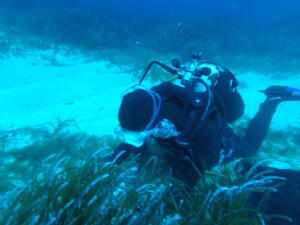News from the ARTEMIS Project
The ARTEMIS Project studies the ecological status of the Posidonia meadow in Cala Blanca, Ciutadella

Scientists from the Mediterranean Institute for Advanced Studies (IMEDEA) and OBSAM-IME are beginning the preliminary studies for the restoration of the Posidonia meadow as part of the European INTERREG ARTEMIS project being carried out in Menorca.
The Posidonia oceanica meadow located off the coast of Cala Blanca (Menorca) will be one of the four pilot sites in the Mediterranean for the INTERREG EuroMED ARTEMIS project, along with three others located in Crete (Greece), and in Italy: Sardinia and Monfalcone. The project plans to implement restoration initiatives for these seagrass meadows, as well as assess the economic and financial value of the benefits these important ecosystems provide to society.
Understanding the biodiversity status of the meadow before restoration
Underwater data collection campaigns are currently being conducted in Menorca to assess the initial status of the Posidonia meadow and its associated biodiversity. The goal is to establish a baseline that will allow scientists to monitor changes and evaluate the restoration’s impact over time.
The methodology follows the guidelines set by ARTEMIS project partners to evaluate the ecosystem services baseline in a consistent way across the four pilot sites.
Data collected includes: seabed coverage by the meadow, Posidonia shoot density, vertical growth rate of the rhizome, biomass of epiphytes (organisms that grow on the plant’s leaves), herbivory pressure, fish population surveys to estimate diversity and abundance, benthic macrofauna (invertebrates), and more. These data, along with laboratory sample processing, will help calculate biodiversity indicators and determine the meadow’s ecological condition.
The team consists of four IMEDEA researchers with extensive experience in Posidonia studies. According to Jorge Terrados, lead IMEDEA researcher: “It is essential to carry out this prior characterization of the ecosystem before intervention to later evaluate the success of the restoration.” Eva Marsinyach, marine environment technician at OBSAM-IME, adds: “This is the first time we’re applying this Posidonia and biodiversity assessment methodology at OBSAM-IME. It’s a great opportunity to apply new techniques and compare results with other Mediterranean regions.”
Evaluating the capacity for blue carbon storage
Previous months have also included scientific studies to determine the “blue carbon” capacity — that is, the meadow’s ability to sequester carbon and help mitigate climate change.
These studies are being conducted by a research team from the Blanes Center for Advanced Studies (CEAB-CSIC), led by researcher Oscar Serrano. The study aims to determine how much carbon is stored in the meadow, providing new scientific data on Posidonia’s key role in marine ecosystems.
Blue carbon is organic carbon captured and stored by oceanic coastal ecosystems like mangroves, marshes, and seagrass meadows. Unlike terrestrial ecosystems, this carbon can remain trapped for centuries to millennia in the marine sediments — making it vitally important.
The ultimate goal: restoring a degraded meadow
The goal in Cala Blanca is to restore an area of 1,800 m² of Posidonia meadow that nearly disappeared due to an accidental bentonite spill during the construction of the seawater intake tower for the Ciutadella desalination plant. This degraded area, where the cause of damage is no longer present, has been selected for transplantation of live plants, accompanied by scientific monitoring to assess feasibility and progress.
The project plans for restoration to begin at the end of this year or early next year. Surrounding areas show healthy Posidonia meadows, which could facilitate the recovery of the restored zone.
The restoration methodology, developed by the IMEDEA research group, has already proven successful in Pollença Bay, Mallorca (Red Eléctrica’s Marine Forest project), and was recently used to restore part of a Posidonia reef in Fornells Bay, Menorca.
The ARTEMIS Project
ARTEMIS aims to accelerate the restoration of Mediterranean seagrass meadows by integrating the economic and social benefits of ecosystem services into public and private policies. The project promotes collaboration among local and international stakeholders using innovative solutions for biodiversity conservation and sustainable marine area management.
Key outcomes include implementing advanced restoration protocols in pilot sites across the Mediterranean that promote biodiversity, carbon sequestration, and climate resilience.
Currently, seagrass meadows cover around 25% of the Mediterranean seabed at depths between 0 and 40 meters. However, over the past 50 years, they have declined by an estimated 34%. Beyond their ecological value, Posidonia meadows are among the most effective carbon sinks, burying about 50% of marine sediment carbon worldwide. They also support roughly 25% of Mediterranean species, serving as breeding, nursery, or permanent habitat zones.
OBSAM-IME, one of ten ARTEMIS project partners
OBSAM-IME shares the project with partners including: Plan Bleu for the Environment and Development in the Mediterranean (Project leader, France), Hellenic Centre for Marine Research (HCMR, Greece), Italian Institute for Environmental Protection and Research (ISPRA), Non-profits MEDSEA Foundation and The Green Tank, Municipality of Monfalcone (Italy), Companies ECOACSA, BAX, and EY Denkstatt (Bulgaria)
In addition to OBSAM-IME, three Balearic organizations have joined ARTEMIS as IME-associated partners: Ministry of Agriculture, Fisheries, and Natural Environment of the Balearic Government, Menorca Preservation and Island Council of Menorca.